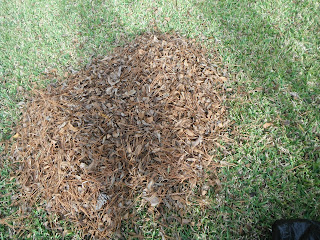To read more about Cecilia and her efforts check out this article on MSN
Growing Wild in the City
Until next time my fellow environmentalists
Josh
 |
| Wild Flowers of Lakota, ND |
This blog chronicles my journey as I try to live a sustainable lifestyle and be a good steward of the Earth.
 |
| Wild Flowers of Lakota, ND |
 Every year a ritual takes place across the country and the world. This annual chore takes place usually in the fall or winter months and is either loved or hated depending on how much you did it as a child. I am of course talking about the wonderful, joyous chore of raking your lawn. This job is treated by many as a burdensome waste of time with you endlessly raking, bagging and disposing of your leaf litter at the local dump or burn pile. For others it is a great opportunity for to add to the community compost pile in which all this leaf litter can be disposed of naturally and makes a perfectly useful substance.
Every year a ritual takes place across the country and the world. This annual chore takes place usually in the fall or winter months and is either loved or hated depending on how much you did it as a child. I am of course talking about the wonderful, joyous chore of raking your lawn. This job is treated by many as a burdensome waste of time with you endlessly raking, bagging and disposing of your leaf litter at the local dump or burn pile. For others it is a great opportunity for to add to the community compost pile in which all this leaf litter can be disposed of naturally and makes a perfectly useful substance.  The only money I spent on it was the gas in the car to pick up the pallets and little bit on screws to assemble it. In return I will get nutrient rich compost at a fraction of the cost of commercially bought compost and you can control what was put in the bin.
The only money I spent on it was the gas in the car to pick up the pallets and little bit on screws to assemble it. In return I will get nutrient rich compost at a fraction of the cost of commercially bought compost and you can control what was put in the bin.  I have always wanted to test out cold season gardening utilizing the combination of cold season crops such as radishes, beets, spinach and various lettuces and the protective cover of the greenhouse. With my budget small and a my space limited I made use of left over materials from a deck railing removal to build a simple triangle greenhouse.
I have always wanted to test out cold season gardening utilizing the combination of cold season crops such as radishes, beets, spinach and various lettuces and the protective cover of the greenhouse. With my budget small and a my space limited I made use of left over materials from a deck railing removal to build a simple triangle greenhouse.  I then attached the frame to a existing raised bed planting box using a pair of door hinges. Finally I covered the frame in 2 mm thick plastic sheeting in order to create the desired greenhouse effect. Inside I planted cherry tomato and two pepper seedlings in the back row. While these are not typical cool season crops I was curious to see if they would survive under the makeshift protection of my greenhouse. For cool season crops I planted Detroit Dark Red Beets, Crimson Giant Radishes, Simpson Elite and Mesclun Lettuce, and finally Bloomsdale Long Standing Spinach and Salad Select Spinach.
I then attached the frame to a existing raised bed planting box using a pair of door hinges. Finally I covered the frame in 2 mm thick plastic sheeting in order to create the desired greenhouse effect. Inside I planted cherry tomato and two pepper seedlings in the back row. While these are not typical cool season crops I was curious to see if they would survive under the makeshift protection of my greenhouse. For cool season crops I planted Detroit Dark Red Beets, Crimson Giant Radishes, Simpson Elite and Mesclun Lettuce, and finally Bloomsdale Long Standing Spinach and Salad Select Spinach.